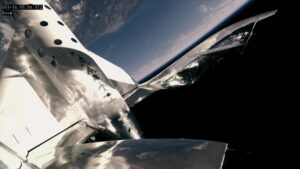Virgin Galactic prepares to transition to operations
By Jeff Foust

WASHINGTON — Virgin Galactic executives said Nov. 5 that the company is ready to begin a final series of test flights of its SpaceShipTwo suborbital vehicle as the company attempts to move into commercial operations in 2021.
In its release of its third quarter financial results and accompanying earnings call, the company said it is preparing to perform its first powered SpaceShipTwo flight from Spaceport America in New Mexico between Nov. 19 and 23. That flight will carry two pilots, CJ Sturckow and Dave Mackay, going beyond above the 80-kilometer altitude that the company, like U.S. government agencies, defines as space.
The flight, the first time SpaceShipTwo has flown under rocket power since February 2019, will be used to test the new cabin interior design developed for future commercial flights. Mike Moses, president of space missions and safety at Virgin Galactic, said on the earnings call that the flight will test cameras and communications systems for livestreaming future flights, as well as upgrades to the vehicle’s horizontal stabilizer and flight control system. It will also carry four payload racks for NASA’s Flight Opportunities suborbital research program.
If that flight is successful, Virgin Galactic will perform a second test flight in the first quarter of 2021. That will carry four employees in the cabin in addition to the two pilots. Those employees will test the cabin interior and other hardware, as well as “the weightless experience in space,” Michael Colglazier, chief executive of Virgin Galactic, said.
A third flight would follow late in the first quarter with company founder Richard Branson on board. A presentation during the call said that the flight will carry “passengers,” but Colglazier said that the company considered that flight a continuation of the test program. “Who better to assess the experience of what we’re doing here?” he said of Branson.
However, Colglazier made clear the company was in the final phases of that test flight program. “After 15 years of development and testing, we are at the cusp of achieving technological feasibility, and this marks an inflection point in the company’s journey,” he said. “The next chapter of Virgin Galactic is to use this system to bring thousands and thousands of people to space.”
To that end, the company expects to resume ticket sales after Branson’s flight. Virgin Galactic created a waiting list with an initiative called “One Small Step” introduced in February, where potential customers paid a $1,000 deposit to be first in line when ticket sales resume. Colglazier said nearly 900 people have signed up for the One Small Step program, which will be closed at the end of the year.
The company has not disclosed what price it will charge for tickets when sales resume. Virgin had been charging $250,000 when it halted ticket sales after a fatal 2014 test flight accident. Colglazier suggested that the company may charge significantly more than that, mentioning how the company’s “incomparable experience can support our pricing strategies over time” and that he was “very bullish on the transformational experience that we intend to deliver and the price points we can command for this one-of-a-kind, supply-constrained product.”
In addition to increasing revenue, he said the company would seek to cut costs. Starting in early 2021 the company will identify “spending inefficiencies,” but didn’t he elaborate on what those might be, such as personnel reductions. He did praise the “extraordinary people” working for Virgin Galactic, but that the company would also be “a great stepping-off point for people’s careers.”
Part of that transition from development to operations includes adding SpaceShipTwo vehicles to the fleet. The next SpaceShipTwo is nearing completion, with a formal rollout ceremony scheduled for the first quarter of 2021. The company had hoped to complete the vehicle — often called its second but actually its third, when counting the vehicle destroyed in the 2014 crash — this year, but Colglazier said “scheduling and cost inefficiencies” caused by the pandemic delayed its completion.
Colglazier, who took over as chief executive in July after a long career at Disney, described in the earnings call a long-term vision of flying 400 times a year from Spaceport America, and later other spaceports, generating $1 billion in annual revenue. That flight rate, he said, would require several SpaceShipTwo vehicles as well as WhiteKnightTwo carrier aircraft. He didn’t give a date for achieving that goal beyond it being a “multiyear objective that accelerates now.”
The company reported no revenue in its fiscal third quarter, with a loss of $76.9 million. The company’s reserves, though, grew to $742 million thanks to $440 million it raised in a secondary offering of stock in August.
November 6, 2020 at 07:20AM
via SpaceNews read more...

Post a Comment